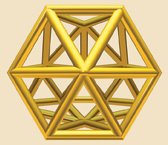Feeling cagey
- More than 2 years ago
Researchers have discovered that gold can take the shape of nanoscale, hollow cages similar to carbon buckyballs. Lai-Sheng Wang of Washington State University in Richland, Xiao Cheng Zeng of the University of Nebraska in Lincoln, and their coworkers bombarded a piece of gold with a laser in a vacuum and studied the clusters that arose.

Typically, “metals like to form close-packed structures,” says Wang. But when 16 to 18 atoms joined, they formed empty cages. The researchers don’t yet know whether the gold-lattice cages would survive outside the vacuum, but placing a nongold atom within the 0.6-nanometer-diameter frames might stabilize them. In an upcoming Proceedings of the National Academy of Sciences, the group provides evidence for the structures. A model of the 16-atom version is shown here.







